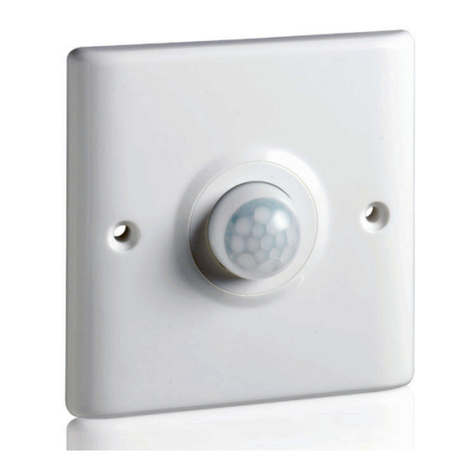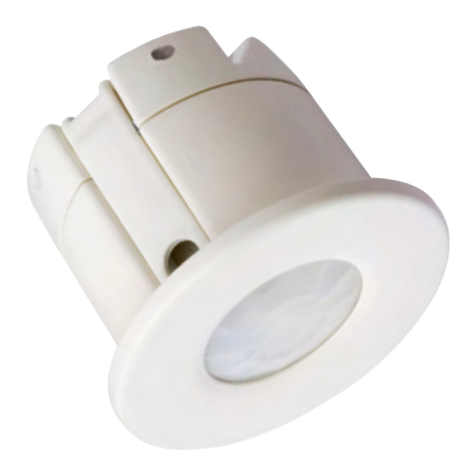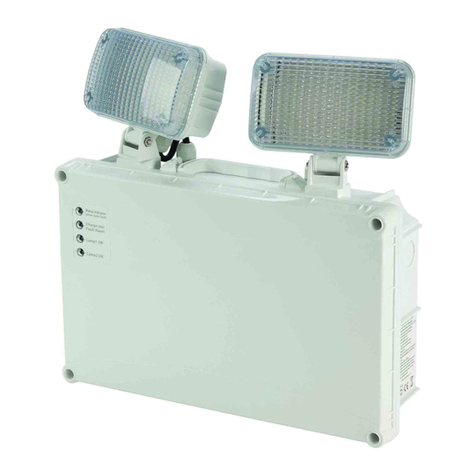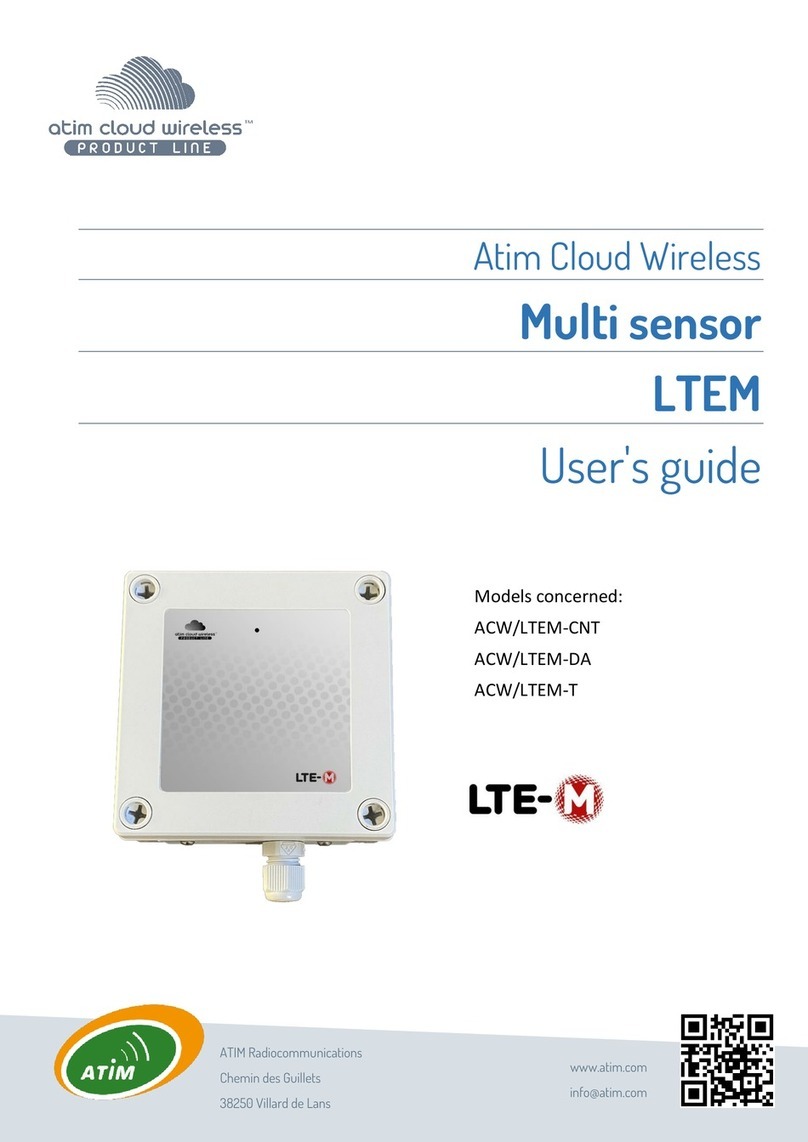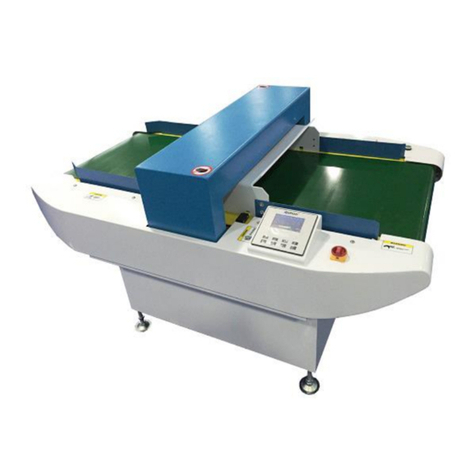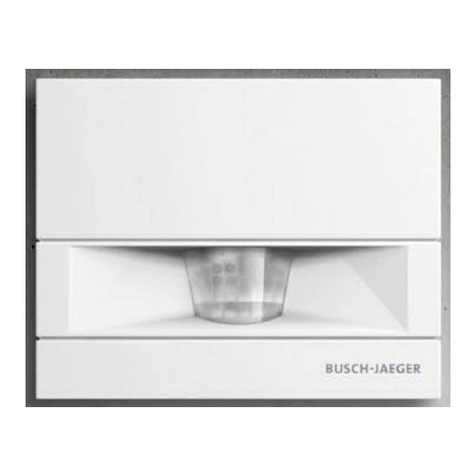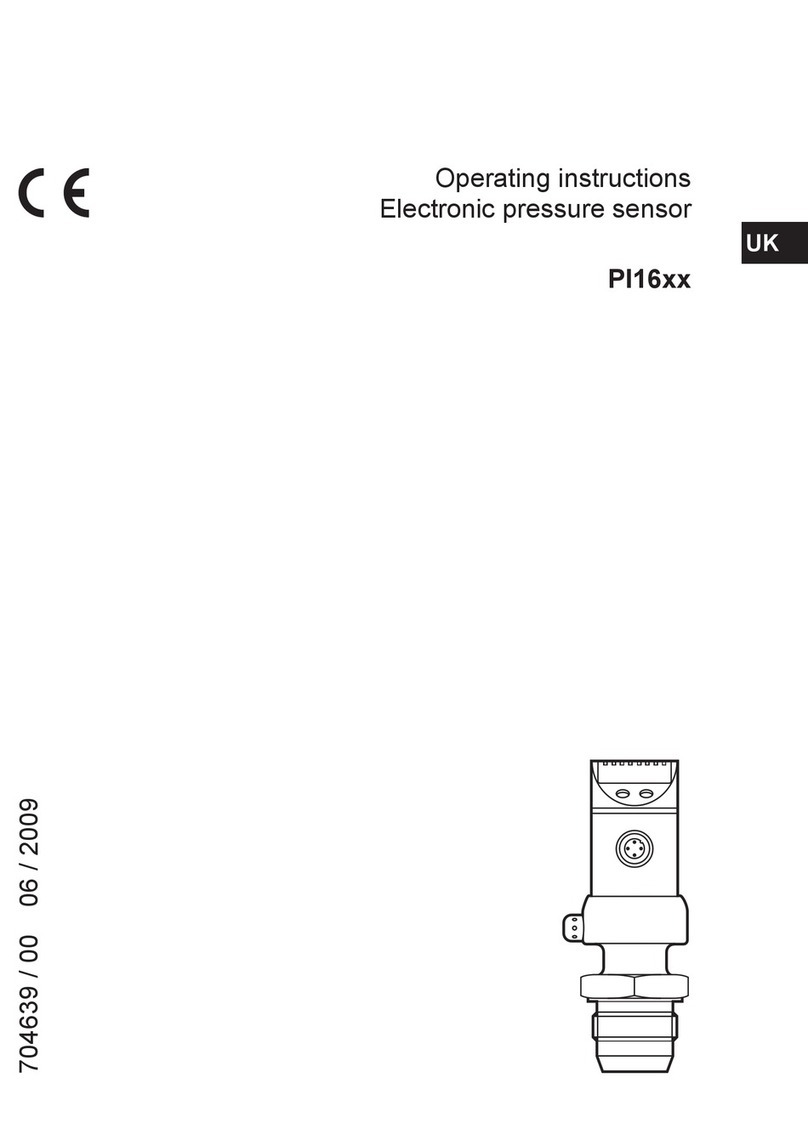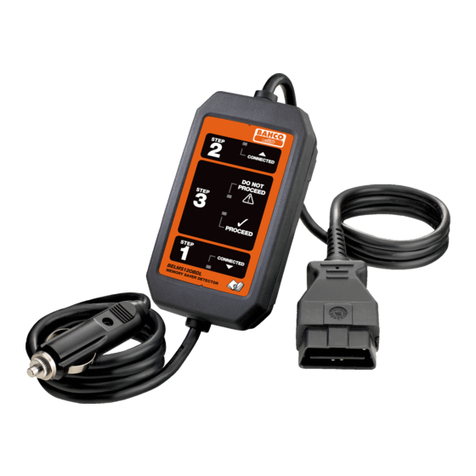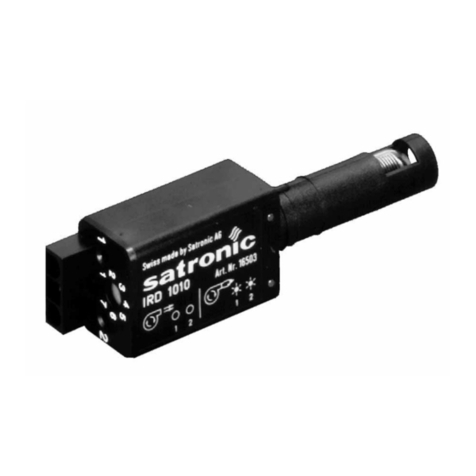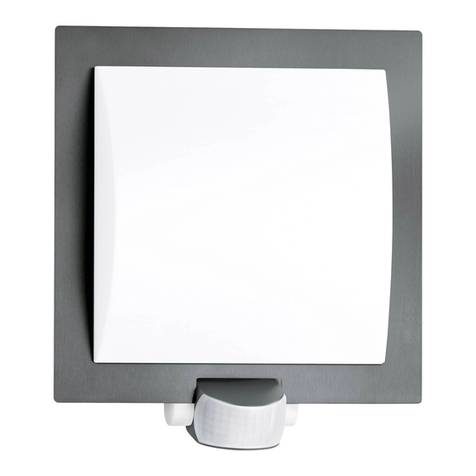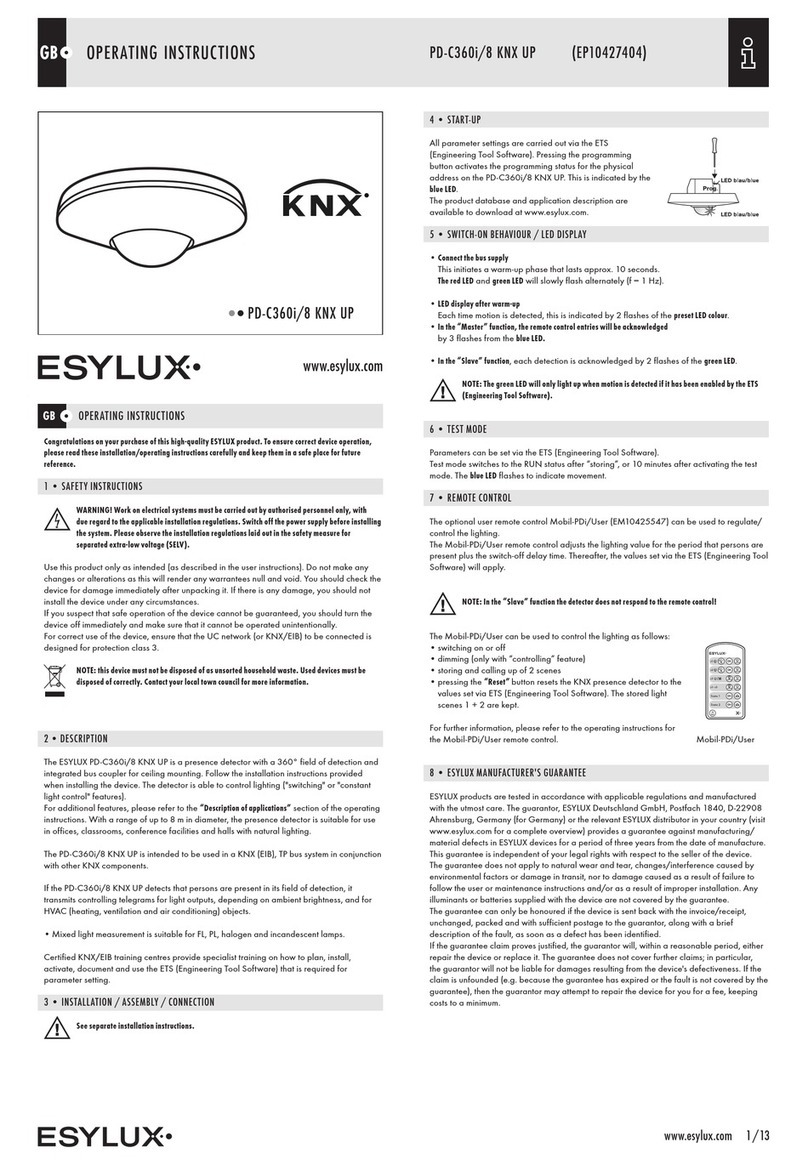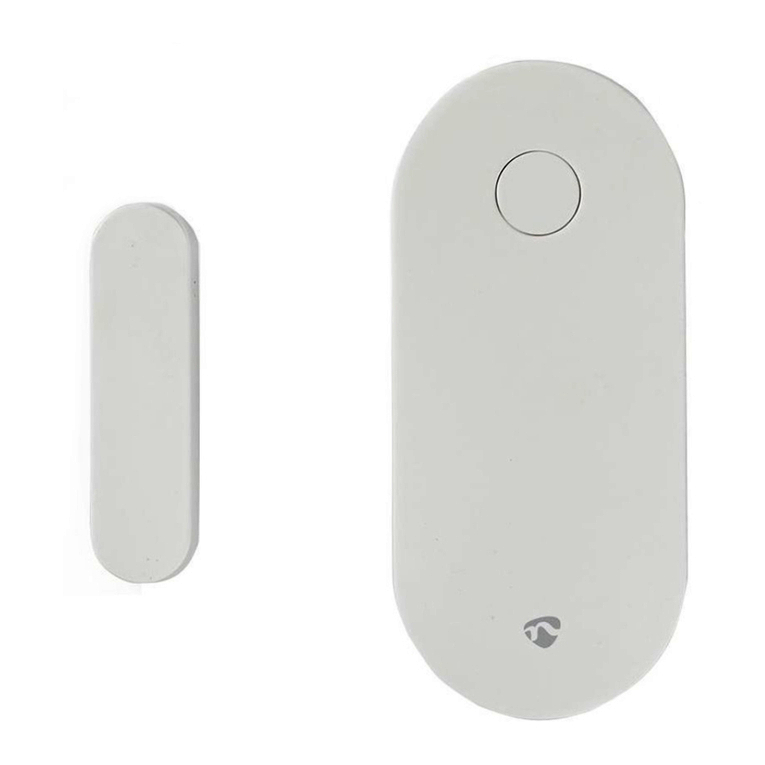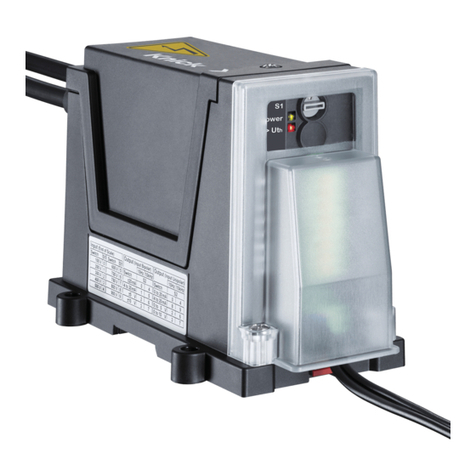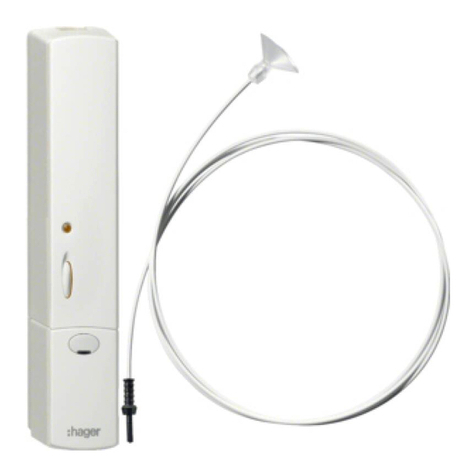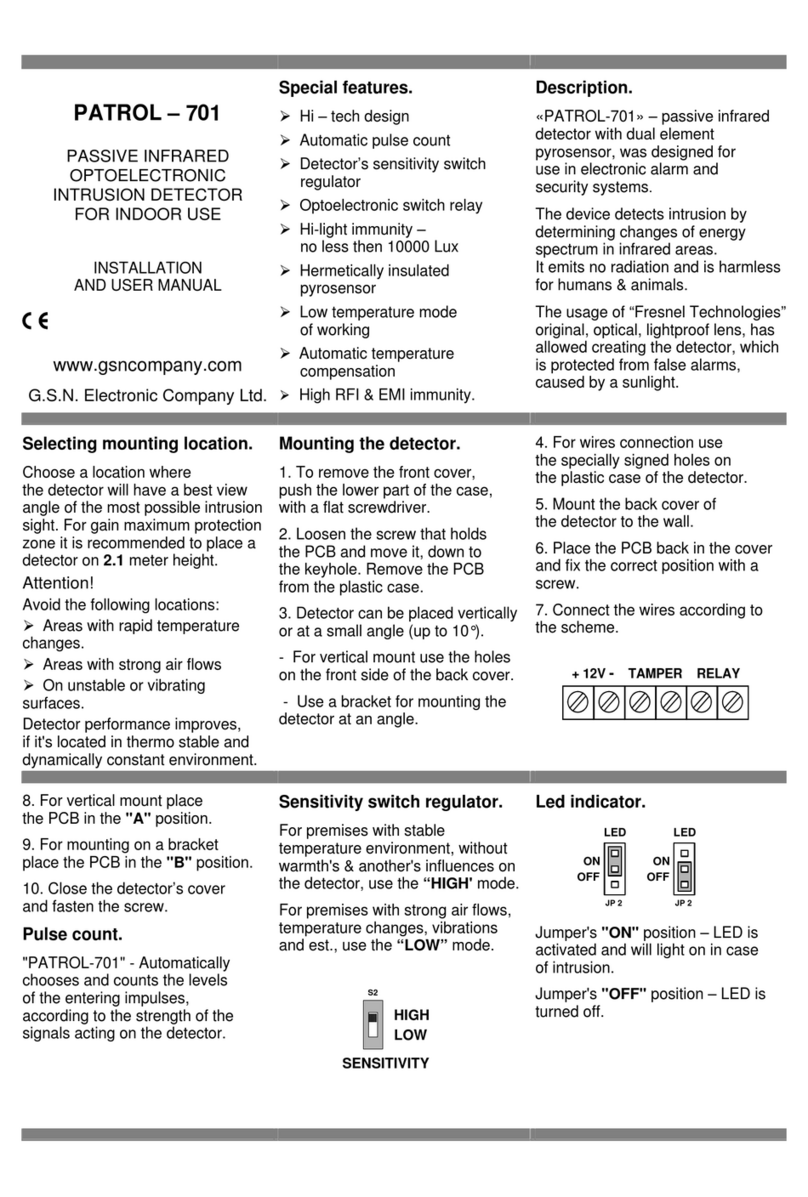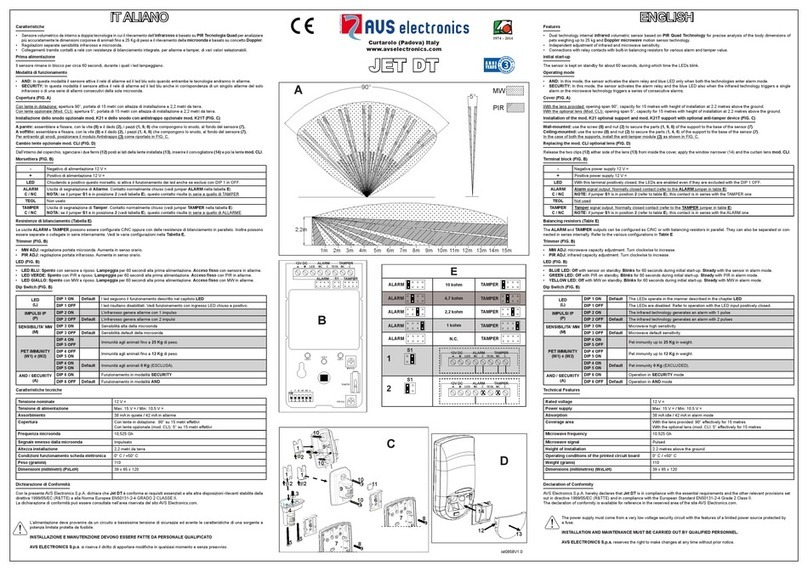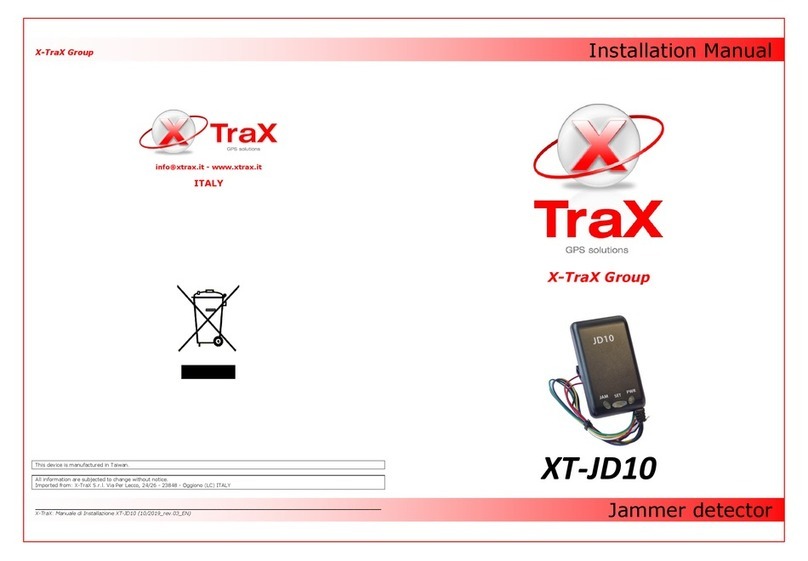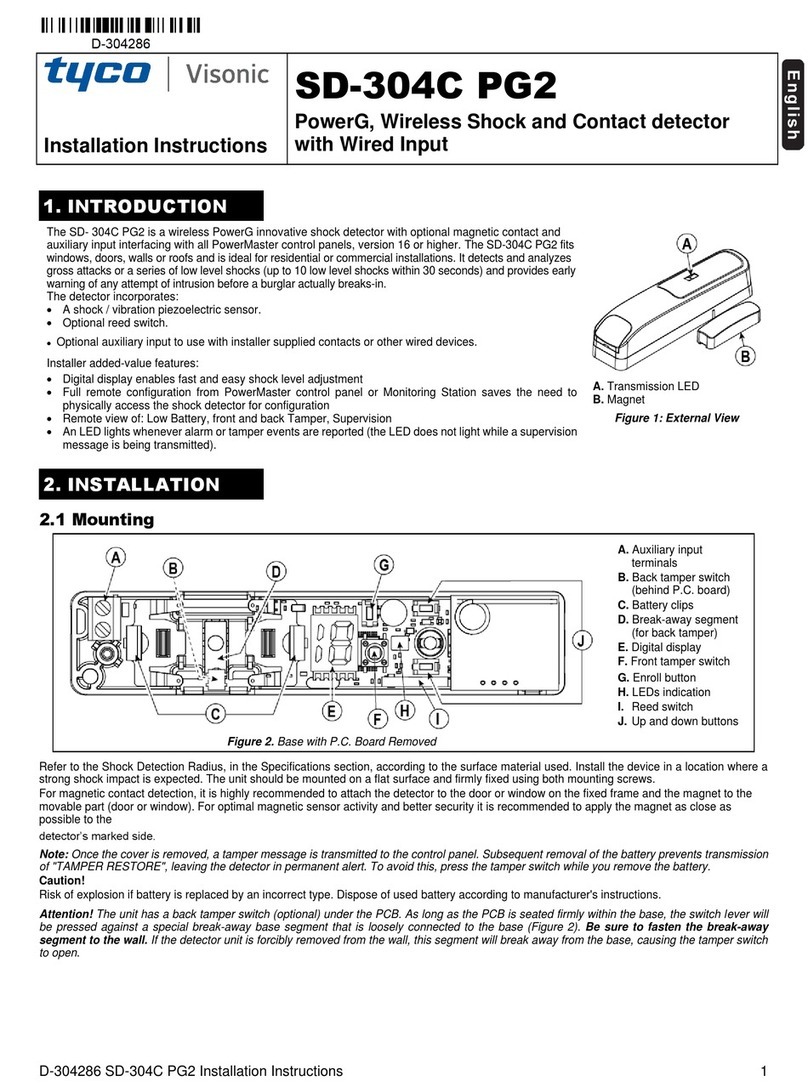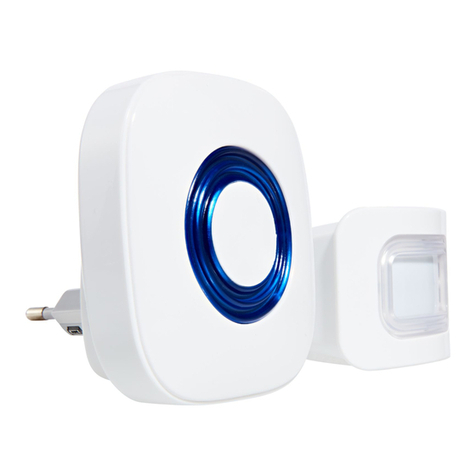Newlec NL5701B User manual

KEY FEATURES
Ratin at 240V AC 50Hz
All load types 10A
Time Delay 2min - 1h
Sensitivity Adjustment
Test Mode
Auto and Manual Lux Sensor for Dayliht Control
IMPORTANT NOTICE
All wirin should be carried out by a competent person or a qualified electrician and should be fitted to IEE Wirin reulations BS7671.
The circuit should be isolated before carryin out any work. Failure to adhere to the instructions will invalidate the warranty.
Instructions
Newlec Helpline: 0800 783 6909 RPM 377
PRODUCT RANGE
OCCUPANCY DETECTOR
CEILING MOUNTED
PART NUMBER
NL5701B THREE WIRE
USAGE
The Occupancy Detector sensor has been desined to switch
lihtin, heatin and ventilation loads up to 10A. The unit is
switched on by the detection of movin infra red heat within a
specified rane. When infra red heat, such as a movin body,
is no loner detected, the unit will switch o the load after the
adjustable time period has elapsed. If infra red heat is detected
aain durin the timin period, the timin sequence will restart.
The unit has a lux level adjustment and Auto Lux function, which
measures the ambient liht levels and prevents lihtin bein
switched on, when there is sucient lihtin in the room. There
is a sensitivity adjustment and test mode function added for your
convenience.
The Ceilin Mount Occupancy Detector comes with surface and
flush mounted options. It also has interchaneable white and
chrome fascias.
A power factor correction capacitor of 4 microfarads will often be
required when NewlecNL5705A switchin low wattae loads, e..
LED loads. The capacitor is fitted across switch live and neutral.
RPM377
CEILING MOUNT (PIR)TIMER
IMPORTANT NOTICE
All wiring should be carried out by a competent person or a qualified electrician and should be fitted to IEE 17th Edition Wiring regulations
BS7671:2008. The circuit should be isolated before carrying out any work. Failure to adhere to the instructions will invalidate the warranty.
CEILING MOUNT(PIR)TIMER
PRODUCT: NL5701B THREE WIRE
RATING AT 240V AC 50Hz
• All load types 10A • Time Delay 2min - 1h • Sensitivity Adjustment
• Test Mode • Auto and Manual Lux Sensor for Daylight Control
Removing the Sensor from
Surface Mount Box
Squeeze
the housing
on either side as shown here
DIAGRAM 1
The Ceiling Mount PIR comes with surface and flush mounted options. It
also has interchangeable white and chrome fascias.
USAGE
The PIR sensor has been designed to switch lighting, heating and ventilation
loads up to 10A. The unit is switched on by the detection of moving infra red
heat within a specified range. When infra red heat, such as a moving body, is no
longer detected, the unit will switch off the load after the adjustable time period
has elapsed. If infra red heat is detected again during the timing period, the
timing sequence will restart. The unit has a lux level adjustment and Auto Lux
function, which measures the ambient light levels and prevents lighting being switched on, when there is sufficient lighting in the room.
There is a sensitivity adjustment and test mode function added for your convenience.
A POWER FACTOR CORRECTION CAPACITOR OF 4 MICROFARADS WILL OFTEN BE REQUIRED WHEN SWITCHING LOW WATTAGE LOADS, e.g.
LED LOADS. THE CAPACITOR IS FITTED ACROSS SWITCH LIVE AND NEUTRAL SUPPLIES OF SUITABLE NEWLEC CAPACITORS CAN BE FOUND AT YOUR
STOCKIST (REF NL5705A). DO NOT INSULATION RESISTANCE TEST THIS PRODUCT. REMOVE BEFORE TESTING OR TEST CIRCUIT PRIOR TO FITTING.
POSITIONING
CAREFUL POSITIONING IS ESSENTIAL TO OBTAIN
OPTIMUM PERFORMANCE.
Use the detection range to determine a suitable location for
the sensor. When locating the position of the units, ensure the
sensor is not subjected to bright or direct sunlight or in
areas with high reflective surfaces. Do not site units on a
vibrating surface, or near forced air heating and ventilation.
They should not be placed within 1 metre of the load.
Sensors work when objects move across their field of view.
Position the sensor where people will be detected walking
across the zones rather than towards the zones identified
in Diagram 1. Adjust sensitivity to suit the area that the sensor
has been installed in.
Surface
Mount
Box
Removable
Fascia
TROUBLESHOOTING GUIDE
Before calling Technical Help we recommend that you attempt to resolve the issue for yourself with this handy troubleshooting guide.
Issue Problem and Resolution
Load will not switch OFF • Check terminal connections.
• Check time settings (See Diagram 4).
• PIR is too close to load - Re-position away from lighting, heating and forced air ventilation.
• PIR is switching low wattage or LED loads - Fit Capacitor as stated in instructions NL5705A.
• Windy weather conditions - Adjust Sensitivity down.
• PIR is re triggered - Check area is left unoccupied for longer that time setting using an
accurate time piece.
• Sensitivity set too high - Gradual incremental adjustments towards the low setting to
resolve the issue.
Load will not switch ON • Check terminal connections.
• Lux set too low - Turn off Auto Lux and turn UP lux level to the PLUS (+) setting and wait
for sensor to adjust.
• Sensitivity set too low- Gradual incremental increases towards the High setting to
resolve the issue.
Load switches OFF and • Check terminal connections.
then immediately comes • PIR is detecting normally- Find source that is triggering PIR.
back ON • PIR is seeing infra red heat from the load- Re-position away from heat source
(See Positioning).
• PIR is switching low wattage or LED loads- Fit Capacitor NL5705A across switch live and
neutral of load.
• PIR is switching a contactor and the contactor chatters or stays ON - Fit a NL5705A
capacitor across the switch live and neutral of the contactor coil.
THIS IS AN ALL MASTER SYSTEM.
DO NOT USE SLAVES WITH THIS PRODUCT. THESE PIR’s CAN ONLY BE WIRED WITH EACH OTHER.
PLEASE BE AWARE OF THE CHANGES TO THE TERMINALS FROM PREVIOUS ELKAY CEILING MOUNT TIMERS.
L IN L OUT N OLD TERMINALS
L IN L OUT N N NEW TERMINALS
Do not wire neutrals unless the terminals are marked with an N.
7 metres approx.
2.4 metres
7 metres approx.
CEILING
FLOOR
Instructions
Newlec Helpline: 0845 123 6539
CEILING MOUNT (PIR)TIMER
Instructions
RPM377
IMPORTANT NOTICE
All wiring should be carried out by a competent person or a qualified electrician and should be fitted to IEE 17th Edition Wiring regulations
BS7671:2008. The circuit should be isolated before carrying out any work. Failure to adhere to the instructions will invalidate the warranty.
Newlec Helpline: 0845 123 6539
Diaram 1
DO NOT INSULATION RESISTANCE TEST THIS PRODUCT. REMOVE BEFORE TESTING OR TEST CIRCUIT PRIOR TO FITTING
CAREFUL POSITIONING IS ESSENTIAL TO OBTAIN OPTIMUM PERFORMANCE
RPM377
CEILING MOUNT (PIR)TIMER
IMPORTANT NOTICE
All wiring should be carried out by a competent person or a qualified electrician and should be fitted to IEE 17th Edition Wiring regulations
BS7671:2008. The circuit should be isolated before carrying out any work. Failure to adhere to the instructions will invalidate the warranty.
CEILING MOUNT(PIR)TIMER
PRODUCT: NL5701B THREE WIRE
RATING AT 240V AC 50Hz
• All load types 10A • Time Delay 2min - 1h • Sensitivity Adjustment
• Test Mode • Auto and Manual Lux Sensor for Daylight Control
Removing the Sensor from
Surface Mount Box
Squeeze
the housing
on either side as shown here
DIAGRAM 1
The Ceiling Mount PIR comes with surface and flush mounted options. It
also has interchangeable white and chrome fascias.
USAGE
The PIR sensor has been designed to switch lighting, heating and ventilation
loads up to 10A. The unit is switched on by the detection of moving infra red
heat within a specified range. When infra red heat, such as a moving body, is no
longer detected, the unit will switch off the load after the adjustable time period
has elapsed. If infra red heat is detected again during the timing period, the
timing sequence will restart. The unit has a lux level adjustment and Auto Lux
function, which measures the ambient light levels and prevents lighting being switched on, when there is sufficient lighting in the room.
There is a sensitivity adjustment and test mode function added for your convenience.
A POWER FACTOR CORRECTION CAPACITOR OF 4 MICROFARADS WILL OFTEN BE REQUIRED WHEN SWITCHING LOW WATTAGE LOADS, e.g.
LED LOADS. THE CAPACITOR IS FITTED ACROSS SWITCH LIVE AND NEUTRAL SUPPLIES OF SUITABLE NEWLEC CAPACITORS CAN BE FOUND AT YOUR
STOCKIST (REF NL5705A). DO NOT INSULATION RESISTANCE TEST THIS PRODUCT. REMOVE BEFORE TESTING OR TEST CIRCUIT PRIOR TO FITTING.
POSITIONING
CAREFUL POSITIONING IS ESSENTIAL TO OBTAIN
OPTIMUM PERFORMANCE.
Use the detection range to determine a suitable location for
the sensor. When locating the position of the units, ensure the
sensor is not subjected to bright or direct sunlight or in
areas with high reflective surfaces. Do not site units on a
vibrating surface, or near forced air heating and ventilation.
They should not be placed within 1 metre of the load.
Sensors work when objects move across their field of view.
Position the sensor where people will be detected walking
across the zones rather than towards the zones identified
in Diagram 1. Adjust sensitivity to suit the area that the sensor
has been installed in.
Surface
Mount
Box
Removable
Fascia
TROUBLESHOOTING GUIDE
Before calling Technical Help we recommend that you attempt to resolve the issue for yourself with this handy troubleshooting guide.
Issue Problem and Resolution
Load will not switch OFF • Check terminal connections.
• Check time settings (See Diagram 4).
• PIR is too close to load - Re-position away from lighting, heating and forced air ventilation.
• PIR is switching low wattage or LED loads - Fit Capacitor as stated in instructions NL5705A.
• Windy weather conditions - Adjust Sensitivity down.
• PIR is re triggered - Check area is left unoccupied for longer that time setting using an
accurate time piece.
• Sensitivity set too high - Gradual incremental adjustments towards the low setting to
resolve the issue.
Load will not switch ON • Check terminal connections.
• Lux set too low - Turn off Auto Lux and turn UP lux level to the PLUS (+) setting and wait
for sensor to adjust.
• Sensitivity set too low- Gradual incremental increases towards the High setting to
resolve the issue.
Load switches OFF and • Check terminal connections.
then immediately comes • PIR is detecting normally- Find source that is triggering PIR.
back ON • PIR is seeing infra red heat from the load- Re-position away from heat source
(See Positioning).
• PIR is switching low wattage or LED loads- Fit Capacitor NL5705A across switch live and
neutral of load.
• PIR is switching a contactor and the contactor chatters or stays ON - Fit a NL5705A
capacitor across the switch live and neutral of the contactor coil.
THIS IS AN ALL MASTER SYSTEM.
DO NOT USE SLAVES WITH THIS PRODUCT. THESE PIR’s CAN ONLY BE WIRED WITH EACH OTHER.
PLEASE BE AWARE OF THE CHANGES TO THE TERMINALS FROM PREVIOUS ELKAY CEILING MOUNT TIMERS.
L IN L OUT N OLD TERMINALS
L IN L OUT N N NEW TERMINALS
Do not wire neutrals unless the terminals are marked with an N.
7 metres approx.
2.4 metres
7 metres approx.
CEILING
FLOOR
Instructions
Newlec Helpline: 0845 123 6539
CEILING MOUNT (PIR)TIMER
Instructions
RPM377
IMPORTANT NOTICE
All wiring should be carried out by a competent person or a qualified electrician and should be fitted to IEE 17th Edition Wiring regulations
BS7671:2008. The circuit should be isolated before carrying out any work. Failure to adhere to the instructions will invalidate the warranty.
Newlec Helpline: 0845 123 6539
TECHNICAL DETAILS
Use the detection rane to determine a suitable location for the sensor. When locatin the position of the units, ensure the sensor is
not subjected to briht or direct sunliht or in areas with hih reflective surfaces. Do not site units on a vibratin surface, or near forced
air heatin and ventilation. They should not be placed within 1 metre of the load. Sensors work when objects move across their field of
view. Position the sensor where people will be detected walkin across the zones rather than towards the zones identifiedin Diaram 1.
Adjust sensitivity to suit the area that the sensor has been installed in.

Instructions
MOUNTING AND INSTALLATION
STEP 1 Please ensure that you position the Occupancy Detector in the correct place by readin the Positionin section of these
instructions. For flush mountin cut a clean hole measurin 64mm in diameter in the chosen area for the sensor. For surface
mountin attach surface mount cup to ceilin with connection cable hanin throuh the middle. Seal any lare holes on ceilin to
prevent air current activation.
STEP 2 Ensure that the mains power to the circuit is switched o. Ensure terminal cover and cable clamp are correctly fitted with
screws supplied. Place the Live In into the Terminal marked Live In and the switched Live Out into the Live Out terminal. Place the
neutral into the connection marked N for neutral. Please note that it is essential that the Live In wire and the switch Live Out and
Neutral are identified prior to commencin installation. To connect multiple units connect the live switch live and neutrals as shown in
Diaram 2. Turn o mains supply for installation as live workin is not recommended and can damae the unit.
STEP 3 For flush mountin fold the two arms up into the vertical position and insert unit into the hole. Release unit ensurin arms are
securely in place. For surface mountin fit surface mount cup onto ceilin or conduit terminal box and return connected Occupancy
Detector into surface mount cup.
STEP 4 Remove the fascia by turnin anti-clockwise to show the lux pot, sensitivity pot and the timin/lux Dip switches. Please adjust
the Lux Level and Sensitivity potentiometer ently without force as this is a sensitive electronic part. After adjustment please wait 30
seconds for chanes to take eect. It is recommend the product is set up initially usin the 10 secs walk test mode.
STEP 5 To set Auto Lux (150 Lux) switch Dip switch 4 to the ON position. This will allow activation of the Occupancy Detector from
Dusk until Dawn only. To set manually then put dip switch 4 o and use the potentiometer to adjust to desired lux level settin. All the
way to the plus settin will allow the Occupancy Detector to switch day and niht. All the way to the minus sets the timer to ZERO lux
and eeftively switches o the Occupancy Detector. To set manually you will need to be present at dusk. (See Diaram 3).
Newlec Helpline: 0800 783 6909
IMPORTANT NOTICE
All wirin should be carried out by a competent person or a qualified electrician and should be fitted to IEE Wirin reulations BS7671.
The circuit should be isolated before carryin out any work. Failure to adhere to the instructions will invalidate the warranty.
Diaram 2
IT IS ESSENTIAL THAT YOU FOLLOW CLOSELY STEPS 1 TO 8 OF THE MOUNTING AND INSTALLATION
INSTRUCTIONS BELOW. FAILURE TO DO SO WILL INVALIDATE THE WARRANTY
RPM 377
DIAGRAM 3
Please note that the black bar denotes the position of the dip switch.
Dip switch 4 is only used for Setting Automatic (150 Lux) or Manual Lux ONLY.
4.
3.
2.
1.
4.
3.
2.
1.
4.
3.
2.
1.
4.
3.
2.
1.
4.
3.
2.
1.
ON DIP
ON DIP
ON DIP
ON DIP
ON DIP
Manual Lux
2 mins 5 mins10 mins15 mins
4.
3.
2.
1.
4.
3.
2.
1.
4.
3.
2.
1.
ON DIP
ON DIP
ON DIP
20 mins30 mins60 mins
LIVE IN
LIVE OUT
NEUTRAL
LUX LEVEL
ADJUSTMENT
SENSITIVITY
ADJUSTMENT
DIL
SWITCHES
Wiring diagram for a single unit.Wiring diagram for wiring multiple devices together.
LIVE IN
LIVE OUT
NEUTRAL
IT IS ESSENTIAL THAT YOU FOLLOW CLOSELY STEPS 1 TO 8
OF THE MOUNTING AND INSTALLATION INSTRUCTIONS
BELOW. FAILURE TO DO SO WILL INVALIDATE THE WARRANTY.
Mounting and Installation
STEP 1 - Please ensure that you position the PIR in the
correct place by reading the Positioning section of these
instructions. For flush mounting cut a clean hole measuring
64mm in diameter in the chosen area for the sensor. For
surface mounting attach surface mount cup to ceiling with
connection cable hanging through the middle. Seal any
large holes on ceiling to prevent air current activation.
STEP 2 - Ensure that the mains power to the circuit is
switched o. Ensure terminal cover and cable clamp are
correctly fitted with screws supplied. Place the Live In into the
Terminal marked Live In and the switched Live Out into the
Live Out terminal. Place the neutral into the connection
marked N for neutral. Please note that it is essential that
the Live In wire and the switch Live Out and Neutral are
identified prior to commencing installation. To connect
multiple units connect the live switch live and neutrals as
shown in Diagram 2. Turn o mains supply for installation
as live working is not recommended and can damage
the unit.
STEP 3 - For flush mounting fold the two arms up into the
vertical position and insert unit into the hole. Release unit
ensuring arms are securely in place. For surface mounting fit
surface mount cup onto ceiling or conduit terminal box and
return connected PIR into surface mount cup.
STEP 4 - Remove the fascia by turning anti-clockwise to
show the lux pot, sensitivity pot and the timing/lux Dip
switches. Please adjust the Lux Level and Sensitivity
potentiometer gently without force as this is a sensitive
electronic part. After adjustment please wait 30 seconds for
changes to take eect. It is recommend product is set up
initially using the 10 secs walk test mode.
STEP 5 - To set Auto Lux (150 Lux) switch Dip switch 4 to
the ON position. This will allow activation of the PIR from
Dusk until Dawn only. To set manually then put dip switch 4
o and use the potentiometer to adjust to desired lux level
setting. All the way to the plus setting will allow the PIR to
switch day and night. All the way to the minus sets the timer
to ZERO lux and eeftively switches o the PIR. To set manually
you will need to be present at dusk. (See Diagram 3).
STEP 6 - To adjust sensitivity turn anti-clockwise to the
High (H) setting to increase sensitivity and clockwise to the
Low (L) to decrease sensitivity.
STEP 7 - To set time please utilise the dip switch timing
diagram above. The black bar denotes dip switch position.
Replace fascia ring by turning anti clockwise
(See Diagram 4).
STEP 8 - The PIR will take approximately 2½ minutes to
initialise and will flash rapidly after the mains power is first
applied to allow the sensor to learn its environment. The
load will be ON after 7 seconds initially, then switch o
after 2½ minutes if there is no detection in the zones.
OPERATION
In standard operation the PIR will now sense infra red heat
when a person or source of heat passes through the
detection zone. Each time the PIR is triggered it will reset
the timer back to the start of the timing period. The unit will
then wait 5 seconds before allowing the PIR to sense and
re trigger the timing period again.
If no one is present in the room or the detection zone is not
passed through, during its set time period, the timer will
time out, turning o the lights or appliance.
The PIR unit will only trigger the lights or appliance if the
ambient light level is below that set on the lux level
adjustment.
4.
3.
2.
1.
ON DIP
Test Mode
10 Secs
4.
3.
2.
1.
ON DIP
Auto Lux
DIAGRAM 2
DIAGRAM 4
Time Settings (Test Mode to 60 mins)
RPM 3 7 7
CEILING MOUNT (PIR)TIMER
IMPORTANT NOTICE
All wiring should be carried out by a competent person or a qualified electrician and should be fitted to IEE 17th Edition Wiri ng regulations
BS7671:2008. The circuit should be isolated before carrying out any work. Failure to adhere to the instructions will invalidate the warranty.
Instructions
Newlec Helpline: 0845 123 6539
IMPORTANT NOTICE
All wiring should be carried out by a competent person or a qualified electrician and should be fitted to IEE 17th Edition Wiri ng regulations
BS7671:2008. The circuit should be isolated before carrying out any work. Failure to adhere to the instructions will invalidate the warranty.
Newlec Helpline: 0845 123 6539
There are now 2 neutral terminals - one or both can be used.
Please note Elkay ceilingmount PIR’s have ONLY one neutral terminal.

4.
3.
2.
1.
4.
3.
2.
1.
4.
3.
2.
1.
4.
3.
2.
1.
ON DIP
ON DIP
ON DIP
ON DIP
2 mins 5 mins 10 mins 15 mins
4.
3.
2.
1.
4.
3.
2.
1.
4.
3.
2.
1.
ON DIP
ON DIP
ON DIP
20 mins 30 mins 60 mins
4.
3.
2.
1.
ON DIP
Test Mode
10 Sec s
STEP 6 To adjust sensitivity turn anti-clockwise to the Hih (H) settin to increase sensitivity and clockwise to the Low (L) to decrease
sensitivity.
STEP 7 To set time please utilise the dip switch timin diaram above. The black bar denotes dip switch position. Replace fascia rin
by turnin anti clockwise (See Diaram 4).
STEP 8 The Occupancy Detector will take approximately 2½ minutes to initialise and will flash rapidly after the mains power is first
applied to allow the sensor to learn its environment. The load will be ON after 7 seconds initially, then switch o after 2½ minutes if
there is no detection in the zones.
OPERATION
In standard operation the Occupancy Detector will now sense infra red heat when a person or source of heat passes throuh the
detection zone. Each time the Occupancy Detector is triered it will reset the timer back to the start of the timin period. The unit will
then wait 5 seconds before allowin the Occupancy Detector to sense and re trier the timin period aain.
If no one is present in the room or the detection zone is not passed throuh, durin its set time period, the timer will time out, turnin
o the lihts or appliance.
The Occupancy Detector unit will only trier the lihts or appliance if the ambient liht level is below that set on the lux level
adjustment.
POSITIONING
CAREFUL POSITIONING IS ESSENTIAL TO OBTAIN OPTIMUM PERFORMANCE
Use the detection rane to determine a suitable location for the sensor. When locatin the position of the units, ensure the sensor is
not subjected to briht or direct sunliht or in areas with hih reflective surfaces. Do not site units on a vibratin surface, or near forced
air heatin and ventilation. They should not be placed within 1 metre of the load. Sensors work when objects move across their field of
view. Position the sensor where people will be detected walkin across the zones rather than towards the zones identified in diaram 1.
Adjust sensitivity to suit the area that the sensor has been installed in.
Diaram 3
Diaram 4
IMPORTANT NOTICE
All wirin should be carried out by a competent person or a qualified electrician and should be fitted to IEE Wirin reulations BS7671.
The circuit should be isolated before carryin out any work. Failure to adhere to the instructions will invalidate the warranty.
Please note that the black bar
denotes the position of the dip
switch. Dip switch 4 is only used
for Settin Automatic (150 Lux)
or Manual Lux ONLY.
Time Settins (Test Mode to 60 mins)
Instructions
Newlec Helpline: 0800 783 6909
4.
3.
2.
1.
ON DIP
Manual Lux
4.
3.
2.
1.
ON DIP
AutoLux
RPM 377

Issue Problem and Resolution
Load will not switch OFF •Check terminal connections.
•Check time settins (See Diaram 4).
•Occupancy Detector is too close to load - Re-position away from lihtin,
heatin and forced air ventilation.
•Occupancy Detector is switchin low wattae or LED loads - Fit Capacitor as
stated in instructions NL5705A.
•Windy weather conditions - Adjust Sensitivity down.
•Occupancy Detector is re triered - Check area is left unoccupied for loner
that time settin usin an accurate time piece.
•Sensitivity set too hih - Gradual incremental adjustments towards the low
settin to resolve the issue.
Load will not switch ON •Check terminal connections.
•Lux set too low - Turn o Auto Lux and turn UP lux level to the PLUS (+) settin
and wait for sensor to adjust.
•Sensitivity set too low- Gradual incremental increases towards the Hih settin
to resolve the issue.
Load switches OFF and then immediately
comes back ON
•Check terminal connections.
•Occupancy Detector is detectin normally- Find source that is trierin
Occupancy Detector.
•Occupancy Detector is seein infra red heat from the load- Re-position away
from heat source (See Positionin).
•Occupancy Detector is switchin low wattae or LED loads- Fit Capacitor
NL5705A across switch live and neutral of load.
•Occupancy Detector is switchin a contactor and the contactor chatters or stays
ON - Fit a NL5705A capacitor across the switch live and neutral of the
contactor coil.
L IN L OUT N
L IN L OUT N N
Instructions
IMPORTANT NOTICE
All wirin should be carried out by a competent person or a qualified electrician and should be fitted to IEE Wirin reulations BS7671.
The circuit should be isolated before carryin out any work. Failure to adhere to the instructions will invalidate the warranty.
TROUBLESHOOTING GUIDE
BEFORE CALLING TECHNICAL HELP WE RECOMMEND THAT YOU ATTEMPT TO RESOLVE THE ISSUE FOR
YOURSELF WITH THIS HANDY TROUBLESHOOTING GUIDE
THIS IS AN ALL MASTER SYSTEM
DO NOT USE SLAVES WITH THIS PRODUCT. THESE OCCUPANCY DETECTOR’S CAN ONLY BE WIRED
WITH EACH OTHER. PLEASE BE AWARE OF THE CHANGES TO THE TERMINALS FROM PREVIOUS
CEILING MOUNT TIMERS.
Do not wire neutrals unless the terminals are marked with an N.
OLD TERMINALS
NEW TERMINALS
RPM 377Newlec Helpline: 0800 783 6909 Manufacturers Address: Newey & Eyre Eale Court 2, Hatchford Way, Birminham B26 3RZ
Table of contents
Other Newlec Security Sensor manuals
